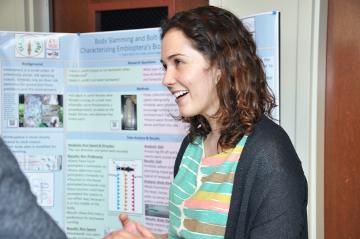
Body slamming and bolt-back behavior: Characterizing embiopterans
E. Taylor Kelly, Tom Libby
Faculty Mentor: Janice Edgerly-Rooks
Large tropical embiopterans, such as Antipaluria urichi (Embioptera: Clothodidae), live in colonies of mothers alongside their offspring and spin copious silk on bark where they graze on lichens. They lack a tough cuticle but in its place, a flexible body capable of tight U-turns and rapid backwards locomotion, which allows them to retreat into their silk domiciles. When dispersing females are threatened, they quickly bolt backwards. Our experiment analyzed their unique backwards run and our research aim was to characterize this method of locomotion. Adult females were challenged with touches to their abdomen, mid-thorax and head; speed and direction of the run were calculated and a detailed analysis of the gait and body kinematics of runners were recorded using a high-speed camera. Videography revealed they utilize an alternating tripod gait typical of hexapods. Interestingly, backwards runners frequently had their thorax slam down against the substrate; the faster they ran, the greater the frequency of body slamming. The embiopteran body plan, with short legs and modified front tarsi, appears ill suited for rapid running, though backwards running may actually help them negotiate their extreme locomotor constraints.